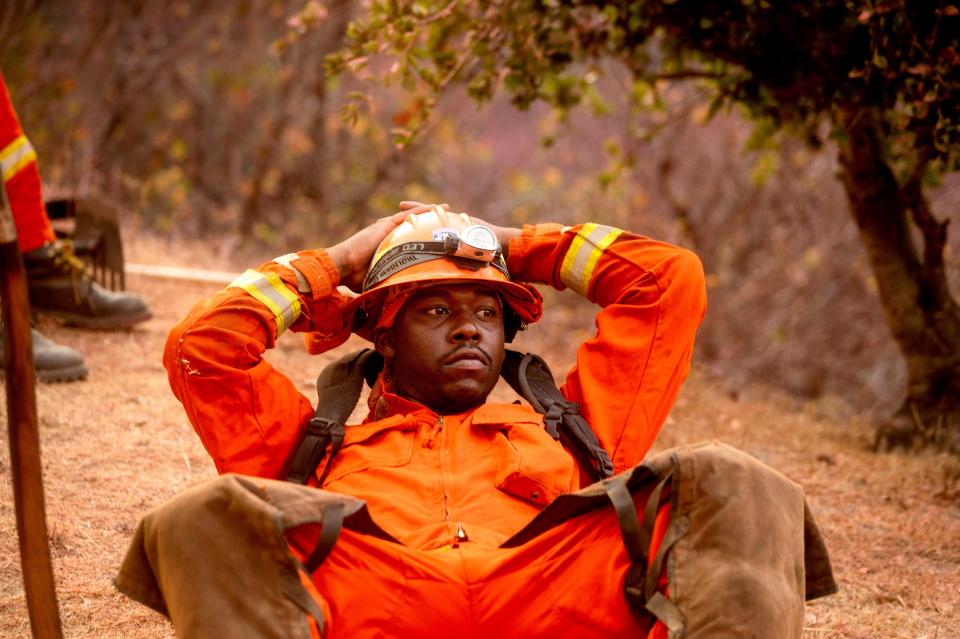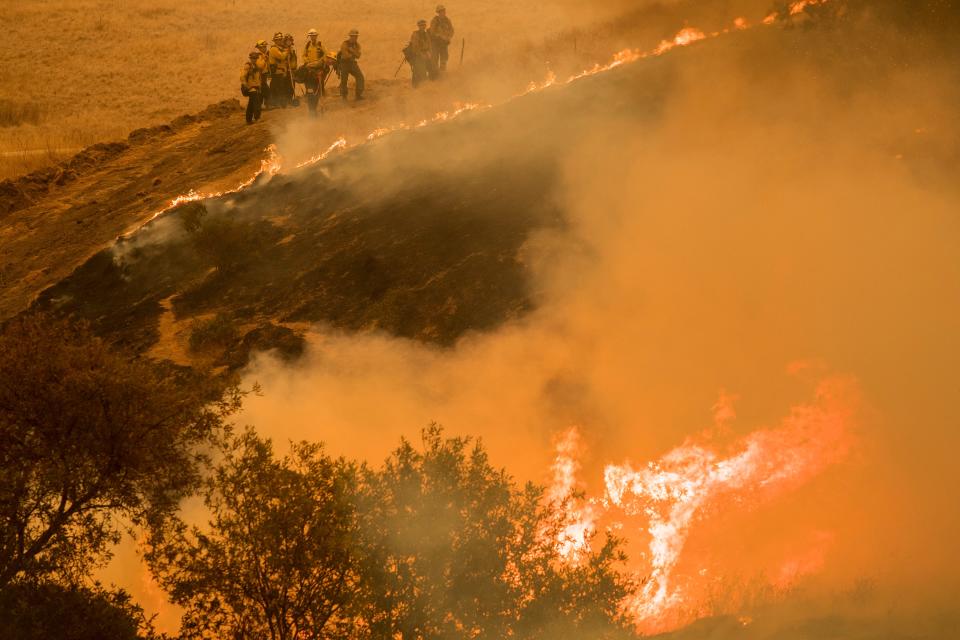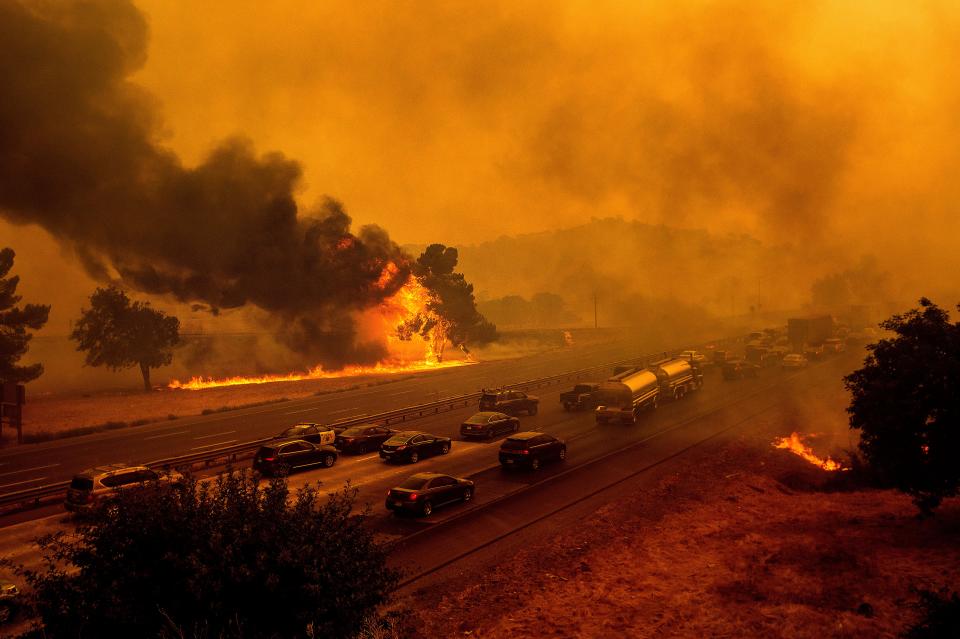More than 370 fires are burning across California, three people dead. Here's what we know.
Hundreds of wildfires are burning across California leading thousands to evacuate –amid a scorching heat wave that is now in its second week.
As of Thursday, blazes threatened thousands of homes and blackened city skies, as firefighters were struggling with containment. At least three people have died.
Hundred of thousands of acres have burned as the fires chewed through brushland, rural areas, canyon country and dense forest to the north, east and south of San Francisco. Flames also carved their way through the wine country and the Sierra Nevada.
“Fires are making runs in multiple directions and impacting multiple communities," a California Department of Forestry and Fire Protection (Cal Fire) statement said Wednesday night.
Gov. Gavin Newsom declared a statewide emergency Tuesday, to help secure availability of resources to combat the fires.
Here's what we know.
Thousands of homes threatened by massive California wildfires; more than 60,000 flee; 2 more deaths reported
Fire terms: What is a fire tornado? 'Extreme fire activity' sparks rare weather warning at Loyalton Fire near Reno.
Three dead, dozens injured
Solano County officials announced Thursday that authorities had found the body of a man while surveying damage from the LNU Lightning Complex Fire in Napa and Sonoma counties, which had more than doubled in size to over 218 square miles.
It was the second death announced that day, and the third total. A Pacific Gas & Electric utility worker assisting with advance clearing died at a fire in the Vacaville area between San Francisco and Sacramento, and a helicopter pilot also died in a crash while battling one of the state's smaller fires in Western Fresno County in central California, according to Cal Fire officials.
The Fresno County Sheriff’s Department has identified the helicopter pilot killed as Michael John Fournier, 52, of Rancho Cucamonga. “He was an amazing, amazing man and I am so proud to be his wife,” LeAnne Fournier told KNBC-TV.
As of Thursday afternoon, 33 civilians and firefighters had been injured in the blazes, according to Cal Fire's assistant deputy director Daniel Berlant.
In Northern California, police and firefighters went door-to-door before dawn Wednesday in a frantic scramble to warn residents to evacuate as fire encroached on Vacaville (a city between Sacramento and San Francisco). Fire officials said at least 50 structures were destroyed and 50 were damaged and that four people were injured.

Tens of thousands evacuated
In all, according to the California Department of Forestry and Fire Protection (Cal Fire), more than 60,000 California residents have evacuated because of fires that are burning about 780 square miles across the state. That's an area equal to about half the size of Rhode Island.
Tens of thousands were under evacuation orders in regions around the San Francisco Bay Area on Wednesday. Smoke blanketed the city, and could be seen from space, per satellites at the National Weather Service.
The ash and smoke in the San Francisco air came from at least seven fires — known as the LNU Lightning Complex — that had burned 480 buildings, including some homes, and threatened 30,000 others in Napa, Sonoma, Lake, Yolo and Solano counties.
Residents of Vacaville were roused before dawn Wednesday by orders to flee.
“The whole sky was red orange...it was massive. I’ve never seen anything like it and it only took a few minutes to get here,” Karen Hansen, who left her small farm as flames approached Tuesday, told the Associated Press.
“You can taste smoke in your mouth," John Gardiner, 60, said.
In Solano County, a rural area southeast of Vacaville, evacuation orders were given to thousands of residents — some fled for the first time ever.
“I’ve lived here for 30 years, never had to evacuate before,” resident Tim Lukehart said. “There’s been fires of course, but not like this one.”
All but three of the "active incidents" (or fires) listed on Cal Fire's website Thursday morning were 50% or less contained.
The LNU Lightning Complex has been active for two days and burned 131,000 acres. As of Thursday, it was 0% contained.
A group of 20 separate fires burning near San Jose has been named the SCU Lightning Complex Fire. On Thursday, 137,475 acres had been burned and the flames were 5% contained. SCU Lightning Complex threatens more than 20,000 structures, according to the SCU branch of CalFire.
In Southern California, an 8-day-old blaze near Lake Hughes in northern Los Angeles County mountains continued to be a threat to 4,570 structures after destroying 21 buildings. It was 52% contained as of Thursday.
Nearly 11,000 lightning strikes, excessive heat sparked fires
Many of the wildfires burning in California today were caused by a perfect storm of extreme heat and consequential lightning.
The heat was generated by a strong ridge of high pressure over the western U.S., which also produced an onslaught of thunderstorms and lightning that ignited the blazes — often pushed by strong winds.
In the past 72 hours we have seen an increase in fire activity across CA due largely to thunderstorms & extremely high temps. NOW is the time to ensure you & your family are prepared. Have a plan & remember, if you feel unsafe, do not hesitate to evacuate. https://t.co/CHdTupzTIa pic.twitter.com/bYeEexHlp4
— CAL FIRE (@CAL_FIRE) August 19, 2020
Terms to know: What are fire whirls, fire tornadoes, fire clouds and running crown fires?
California had recorded nearly 11,000 strikes in 72 hours, Gov. Gavin Newsom said Wednesday.
“This is definitely a historic lightning event,” said Daniel Berlant, an assistant deputy director with the state Department of Forestry and Fire Protection. “The last time we had a lightning siege that was even comparable was in 2008.”
In all, about 21 million people are under excessive heat warnings in the West, mainly in California, Arizona and Nevada. According to the National Weather Service, an excessive heat warning "is a heat index of 105 °F or greater that will last for 2 hours or more."
Widespread elevated and critical fire weather conditions were expected Thursday across central California and the Great Basin, the National Weather Service said. The hot, dry conditions are expected to continue at least into the weekend.
Last weekend, the high heat led to rolling power blackouts because of increased electricity demands.

California sees annual fires because of a combination including fierce autumn winds, frequent drought punctuated by spurts of downpours, homes or terrain that burn easily — and most of all climate change.
“California has a really flammable ecosystem,” University of Colorado fire scientist Jennifer Balch told the Associated Press. “People are living in flammable places, providing ignition, starting the wildfires against a backdrop of a warming climate that is making wildfires worse.”
Area burned by wildfire in California increased more than fivefold since 1972, from a five-year average of 236 square miles a year, to 1,394 square miles a year — according to a 2019 study by Columbia University fire scientist A. Park Williams, Balch and others.
About 97% of the fires in coastal California are started by people, either on purpose or accidentally, a study by Balch found.

How many fires are there?
According to Newsom, firefighters are battling 367 known wildfires across California, including 23 that are considered major fires.
But of those 367 fires, "the prospect of that number going up is very real," he said at a press conference Wednesday.
As of early Thursday, Cal Fire reported that there has so far been a total of 5,762 "incidents," or number of wildfires, over the course of the 2020 fire season.
Recovery efforts
In efforts to contain the blazes, some firefighters were working 72-hour shifts instead of the usual 24 hours, said Cal Fire spokesman Jonathan Cox.
“We’re in the unfortunate position where firefighters are going to be spending several days out on the fire line,” Cox said. “It’s grueling, it’s exhausting.”
Fire Management Assistance Grants (FMAG) have been requested and granted by the Federal Emergency Management Agency (FEMA) this week, to provide federal funding/assistance in combating fires including the LNU Lightning Complex, the Jones Fire, and the Carmel Fire.
Contributing: The Associated Press, Scott Linesburgh, Elinor Aspegren, USA TODAY.
This article originally appeared on USA TODAY: California wildfires: What we know about damage, evacuations, death
